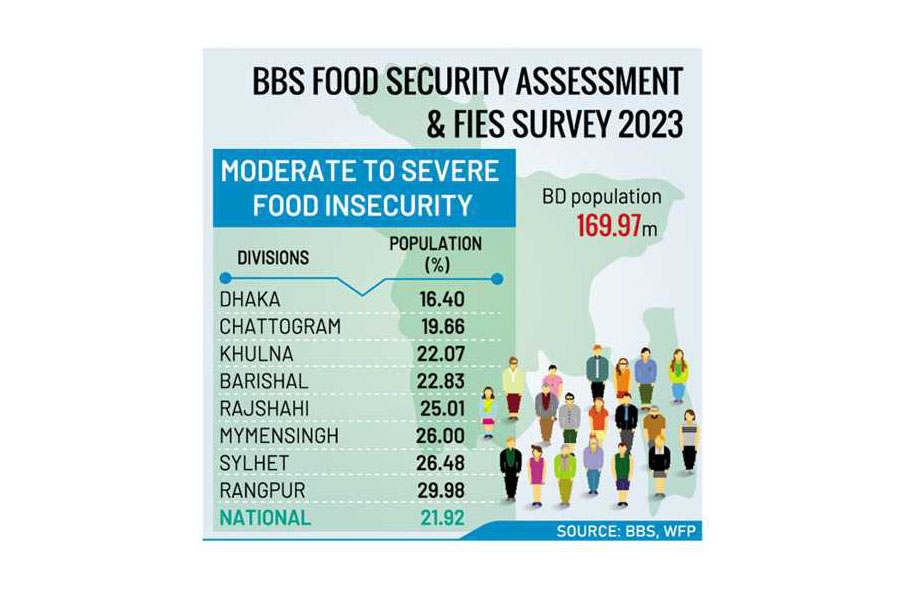Moderate to severe food insecurity stares at 37.24m
Worst in Rangpur, as BBS finds a third of div in want

Published :
Updated :

About 37.24 million people in Bangladesh, who account for nearly 22 per cent of the total population, face moderate to severe food insecurity, a latest official survey shows.
The rate is below 20 per cent only in Dhaka and Chattogram while it is 22 to 30 per cent in six other divisions -- the worst in Rangpur -- as per the key findings of the Food Security Assessment and FIES Survey 2023 and FBS or Food Balance Sheet conducted under the Food Security Statistics Project 2022 under the Bangladesh Bureau of Statistics (BBS).
The findings were disclosed Sunday at a seminar organised by the government's statistical agency, BBS.
BBS Director-General Mohammad Mizanur Rahman presided over the publication event of the key findings while Department of Statistics and Information Management secretary Dr Shahnaz Arefin, Planning Commission (General Economics Dev) Additional Secretary Khan Nurul Amin, FPMU Director-General Shahidul Alam spoke, among others.
The survey was conducted for the purpose of preparing the statistical data required for formulation of national priority-based policies for food security.
For the first time has BBS conducted this survey on food situation at the national level, said the organisers.
The investigation has been conducted by collecting data by direct interviews through CAPI method from a total of 29,760 under 1488 Primary Sampling Units (PSUs) at the field level.
The survey shows rate of moderate to severe food insecurity is 21.91 per cent at the national level while it is highest 29.98 per cent in Rangpur.
Based on the country's population, which is 169.9 million as per BBS latest census, above 37.24 million people are now suffering from food insecurity in Bangladesh.
However, in urban areas, above 21 per cent people are food insecure while its above 24 per cent in villages, but it has been found as low as 11.45 per cent in the city corporations, said the report.
Mizanur Rahman said information had been collected based on meta- data of Index No. 2.1.2 through 8.0 selected questions of SDG and it is a model based estimate which is only a perception about the country's food security.
In terms of the food balance sheet, the total per-capita daily food supply in the country was found increasing.
Based on secondary data, the total food supply per capita per day in 2016 from food balance sheet was 2,461 kilocalories. It increased to 2,516 kilo calories in 2021.
The amount of rice stored in each household in the country could be used for family needs for an average of 51 days.
"It is 63 days in village and 35 days in city and 11 days in city corporations. It could be used up to 9 days in case of wheat," says the report.
However, experts said the latest data on the people with food insecurity also shows that the poverty level might have increased in the country in 2023 than that of the 2022.
HIES 2022 data showed the country's upper poverty level is 18.7 per cent.
"Escalating inflation, including a record high of 12.59 percent in August 2023 and an annual average of 9.42 percent, coupled with a relatively subdued wage growth of 7.7 per cent and a significant appreciation (minimum 30 percent) of the US Dollar against the BDT, undoubtedly pushed thousands into poverty newly in 2023," said Dr M Masrur Reaz, Chairman and CEO of the Policy Exchange of Bangladesh.
He emphasises the interconnectedness of inflation, wage hikes, and employment with the potential impact on food insecurity.
"Achieving a balance in these factors is crucial to addressing and potentially mitigating the challenges associated with rising food insecurity," he added.
tonmoy.wardad@gmail.com


 For all latest news, follow The Financial Express Google News channel.
For all latest news, follow The Financial Express Google News channel.